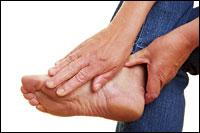 According to the American Chiropractic Association, about 2 million Americans each year suffer from plantar fasciitis. Also known as “heel pain syndrome” this common condition causes inflammation of the band of tissue known as the plantar fascia, which runs from your toes to the heel. If you have plantar fasciitis you may notice sharp pains upon standing that go away after moving around for a bit; however, some people experience heel pain all day long.
According to the American Chiropractic Association, about 2 million Americans each year suffer from plantar fasciitis. Also known as “heel pain syndrome” this common condition causes inflammation of the band of tissue known as the plantar fascia, which runs from your toes to the heel. If you have plantar fasciitis you may notice sharp pains upon standing that go away after moving around for a bit; however, some people experience heel pain all day long.If you’ve tried other conservative measures for treating your heel pain and it’s been unsuccessful, then it may be time to consider how shockwave therapy could help your heel pain in Brooklyn.
What is Extracorporeal Shockwave Therapy?
For those looking for a more extensive treatment to handle their plantar fasciitis, Extracorporeal Shockwave Therapy (ESWT) is often the next option. This non-surgical technique delivers shockwaves to the skin that penetrate the inflamed tissues to help promote healing. This therapy does not employ electricity only high-energy ultrasonic shockwaves. This helps stimulate the body’s natural healing process.
What does ESWT treat?
If you have plantar fasciitis, heel spur syndrome or even Achilles tendonitis that doesn’t seem to experience relief from medication, physical therapy or orthotics, ESWT may be a good option for you. Patients who have not responded to more conservative forms of treatment will find a reduction of symptoms after being treated with ESWT.
What is the treatment process like?
We can perform ESWT in our office and it will not require anesthesia or medication. Upon a thorough examination, your Brooklyn podiatrist will determine whether this therapy is right for you.
First we will apply a gel to the foot (just as you would before any ultrasound) and then we will use a hand piece to transmit these shockwaves to certain areas of the foot. Over the course of the therapy, we will also increase the energy levels to stimulate the most efficient healing response.
How often do I need ESWT?
One session takes only about 15 minutes, and we recommend one sole session per week for a few weeks. This treatment plan will also change depending on the severity of your symptoms.
Are there any side effects?
Since this isn’t a surgical procedure we don’t have to use anesthesia, so the side effects are practically non-existent. Some patients may notice some minor tingling or numbness right after treatment, but this will go away quickly.
If you are suffering from chronic heel pain that hasn’t eased up, it might be time to consider whether ESWT could be right for you. Call us today to schedule your next podiatric visit. Let’s get you on the road to recovery!


